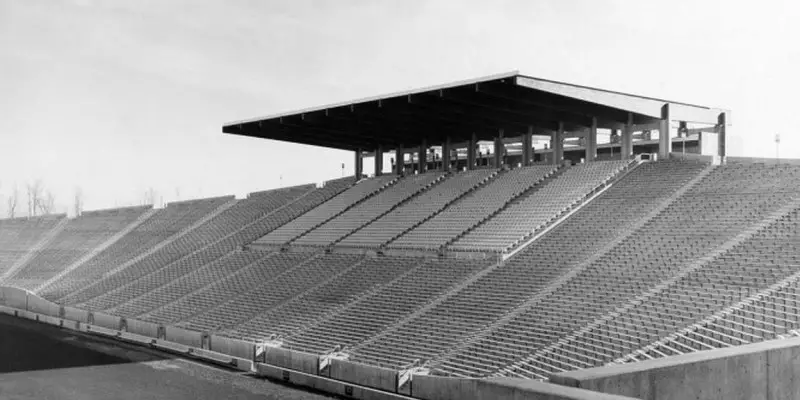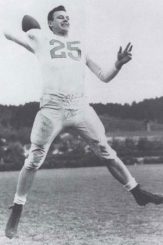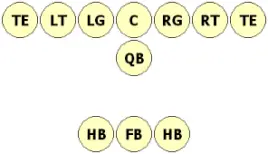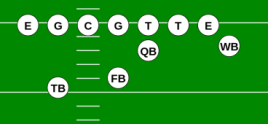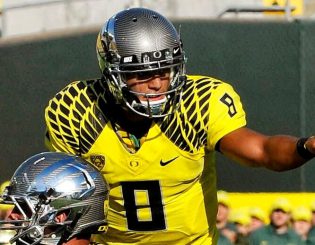In Oregon’s history, there have been many players and coaches of note — from coach Cal Young and his one-game inaugural season in 1984 to Chip Kelly and Marcus Mariota. Although most people say Mariota is the greatest Oregon player of all time, another man held that honor since the 1950s. Back in the era of leather helmets, the hero of the Ducks was a man named Norm Van Brocklin, “The Dutchman.”
After World War II broke out, Oregon did not field a football team for two seasons in 1943 and 1944. This was because many of its players, along with their head coach, Tex Oliver – a West Point graduate — were off fighting in the war, so there were not enough Ducks to field a team. During those two seasons, Oregon fans were left with an amateur team of “Armyducks,” made up of ROTC students and coached by former Duck, John Warren. The Armyducks played and lost four games in ’43 and ’44 combined. Fortunately, the war ended in 1945 and the real Ducks football team returned.
With Oliver coaching the Ducks once again, they had a new focus on the passing game. Despite sophomore tailback Jake Leicht – the quarterback of that era — being named a first team all-American, Oregon went 3-6 in ’45 and 4-4-1 in ’46. In 1947, the Ducks got a new head coach, Jim Aiken, and a new starting quarterback, Norm Van Brocklin.
Although Van Brocklin was on Oliver’s team, he didn’t play much. Oliver said, “He’s only a fair runner and he can’t block,” so Van Brocklin became a backup tailback. Despite the “new focus on the passing game,” Oliver still ran the ball most of the time and had no use for Van Brocklin’s passing ability. However, with Aiken as HC, Van Brocklin’s great passing was featured in a very different kind of offense. While Oliver had run a system that was essentially the Wildcat on every play, Aiken ran an offense much closer to a modern I-Formation. Aiken’s vertical passing T-Offense was the perfect system for Van Brocklin to shine.
Much like the spread-out shotgun of today, the T-Formation was created out of new ideas in an old formation. According to an article by Jeremy Stoltz for BearReport.com, “Walter Camp…began experimenting with the T-formation in the mid 1880s at Yale…it was referred to as the ‘regular formation’ and used by every collegiate team.” The “regular formation” was soon be replaced by the original spread offense, Pop Warner’s Single-Wing — the same offense Oliver ran at Oregon. As Stoltz detailed in another article for BearReport.com, “the single-wing called for the center to lob the ball between his legs to a player standing three to five yards behind him – only the player receiving the snap was not the QB but rather the tailback … The quarterback in that day and age was hardly more than a blocker.” Although Van Brocklin didn’t have the running or blocking prowess to thrive in the Single-Wing, his ability as a polished passer was utilized to startling effect in the T-Formation.
Despite a slow start in ’47, winning 1 of 4 games, the Ducks soon rallied behind Van Brocklin. They finished the season with 6 straight wins, including a 14-6 victory against Oregon State. The Ducks did even better the next season, amassing a 9-1 record with their only loss against a college powerhouse, Michigan. They also made their first appearance in the Associated Press Writer’s Poll, debuting at the 14th spot. The Ducks then rose all the way to 9th prior to being defeated in the Cotton Bowl on New Years Day.
Having earned his degree after three years at Oregon, Van Brocklin decided to forgo his senior year and went into the 1949 NFL Draft, taken 37th overall by the Los Angeles Rams in the 4th Round. He went on to win an NFL championship with the Rams in 1951 — the only championship the Rams won in L.A. — and then win a second championship with the Philadelphia Eagles in 1960, the only team to beat Vince Lombardi’s Packers in a playoff game. Just to show that Van Brocklin’s passing prowess stood the test of time, after 64 years since setting it, he still holds the record for most passing yards in a single game.
Van Brocklin also coached in the NFL for 13 years, but he never captured the success he had as a player. In his tenure as head coach of the Minnesota Vikings, Van Brocklin was more known for fighting with quarterback Fran Tarkenton than winning games. He went on to coach the Atlanta Falcons, leading them to their first winning record in 1971. Van Brocklin retired from the NFL in 1974 after he was fired by the Falcons. With a career that spanned 28 years, Norm Van Brocklin stepped away from the game as both an NFL and Collegiate Hall of Famer.
Even though we all want to get caught up in the new story and success that Mariota had recently, we should all remember that he isn’t necessarily the greatest player in Oregon history. Years from now, we may look back and fairly say that Mariota is truly the best player to ever wear a Ducks jersey, but we must not forget the other heroes of the past. Even if Mariota had the greatest year any Duck ever had at Oregon, it’s unlikely he will match what Norm Van Brocklin did at the pro level. In the end, the choice is yours; Mariota or Van Brocklin. Either way, they were both great and they were both Ducks.
Article Inspiration from Tales From The Oregon Ducks Sideline
by Brian Libby
Top Photo from Imgkid.com
Noah is an undergraduate student from just outside of New Orleans, Louisiana. Noah is currently pursuing a communications degree with the goal of becoming a sports journalist. Noah is a die hard Duck fan, mainly because of his obsession with football’s X’s and O’s. In his free time he enjoys watching both pro and college football games,playing and listening to music, and drawing up his own playbooks.

